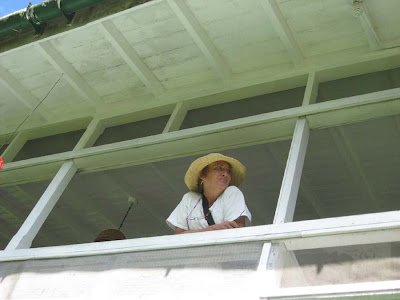January 26th is Australia Day, the day Australia commemorates the arrival of the First Fleet into Sydney Harbour in 1788. Perhaps more importantly, it’s the day for Australians to celebrate being Australian. Like they don’t do that everyday. And believe me they do.
Every day.
Probably a good life lesson for all of us.
From sunrise to sundown yesterday, the Australian flag proudly dwarfed the Canadian and Grenadian flags on Beach House.
The large jar is almost empty. Hint, hint, you Sydneysiders. The smaller one we found in Grenada. Expensive, but another reason to stay here.
So where would an Australian like to spend Australia Day? Besides Australia, I mean. My guess was on the beach with some beer involved. Not a tall order in this corner of paradise.
The anchorage behind Hog Island is popular and fairly crowded.
under the bridge that joins Hog Island to the mainland.
 You can see the bridge in the middle distance to the left in this shot taken from the Hog Island anchorage.
You can see the bridge in the middle distance to the left in this shot taken from the Hog Island anchorage.Cruisers and locals alike flock to the main draw on the beach at Hog Island – Roger’s Beach Bar.
Here’s Roger behind the bar, serving up $5EC drinks (that’s $1.85US). Every drink is the same price and the man pours with a generous hand.
Roger’s wife, Mary, does the cooking.
Welcome to her, hmm, modest kitchen.
 Mary serves up barbeque chicken and pork on Sundays, pizzas once or twice a week, and rotis on occasion. Yesterday the fare was oil down, the national dish of Grenada.
Mary serves up barbeque chicken and pork on Sundays, pizzas once or twice a week, and rotis on occasion. Yesterday the fare was oil down, the national dish of Grenada. Oil down is a simple, robust stew - a combination of salt meat, pieces of chicken, breadfruit, dumplings, black pepper, carrots, callaloo, celery, chives, thyme, and coconut milk. The ingredients are simmered together until the coconut milk becomes oil – that’s when the oil down is ready.
 We didn’t always know what we were eating – what looked to be sausages were the dumplings – but the mystery made it all the more fun.
We didn’t always know what we were eating – what looked to be sausages were the dumplings – but the mystery made it all the more fun.As a special Australia Day treat, there was entertainment. Meet Gilfie – he’s tuning his guitar while his buddy looks after the beverages.
 And even though Gilfie didn’t know any Men At Work tunes or “Waltzing Matilda”, we enjoyed his performance.
And even though Gilfie didn’t know any Men At Work tunes or “Waltzing Matilda”, we enjoyed his performance.The blog photographer doesn’t dance much, which means he can get candid pictures of the Beach House Admiral dancing in the sand.





































































